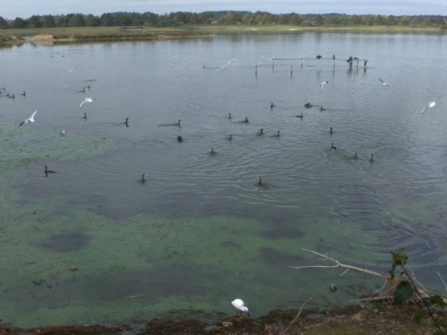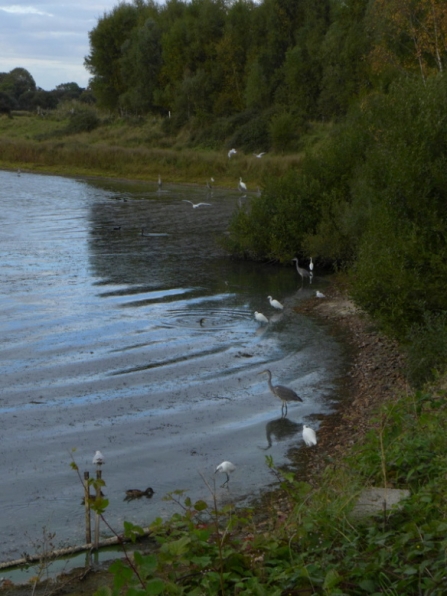I made the most of the cooler conditions to go and do some path trimming. In places the bramble growth has pushed the path almost completely off the gravel surface. I was working near the southern end of Ellingham Lake and the hedge there has some large ivy growths, some of it now flowering and on these I saw a few of the ivy bee Colletes hederae. This is quite large for a solitary bee and flying so late in the season is very obvious, so it seems extraordinary that it was only described as new to science in 1993, since when it has been found over much of Europe. It was first found in the UK in Dorset in 2001 and has now spread as far north as Norfolk.
September’s End
In the late afternoon I went over to Goosander and Lapwing hides. In the reedbed and willows there were a few chiffchaff but no other migrants. From Lapwing hide I saw two green sandpiper and at least one common sandpiper. The screens overlooking the silt pond behind Lapwing hide proved worth a look with two mandarin and two snipe on show and some bullfinch in the willows.
At Goosander hide there has been a feeding frenzy going on for many days now. The cormorant seem to have got a large shoal of small carp hemmed in the bay near the hide and they are attracting everything that can swallow a small fish. There were the cormorant of course along with little egret, a great white egret (Walter this time), grey heron, great crested grebe, little grebe, black-headed gull and even mallard. The mallard and gulls are mostly stealing dropped fish, but a lot of the cormorant seem not to be bothering to eat everything they catch. Sometimes the cormorant are coming up with large perch or even pike. These are also in on the hunt for small carp, but run the risk of becoming a meal themselves in the process.

Cormorant flock fishing for carp
The cormorant dive for the fish which are driven into the weedy shallows in an attempt to escape, where they then run into the line of heron and egret.

Grey heron, little egret and great white egret waiting to the carp to be driven near to the shore
Finally, as I locked up the tern hide right at the end of the day, I was delighted to see the reported wood sandpiper just in front of the hide. It was a juvenile, with fresh yellowish spangled feathers looking very splendid in the golden glow of the setting sun. To add to the scene the grey phalarope flew in and landed some 100m away. Despite trying I could not see the juvenile garganey that was also seen earlier, but tomorrow is another day.

